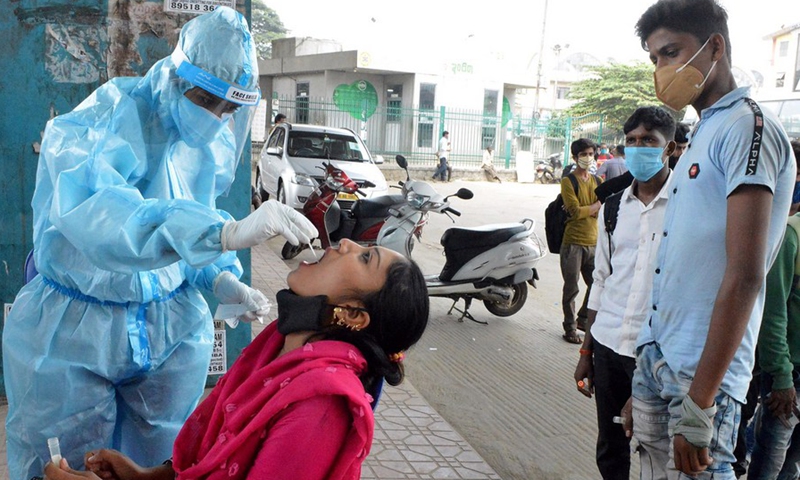2nd wave of COVID-19 has broken out, but less worrying than first: former CDC head
By Ni Hao and Fan Anqi Source: Global Times Published: 2020/10/11 18:16:30

A health worker takes swab samples from a woman for COVID-19 test on the roadside, in Bangalore, India on Oct. 9, 2020. (Str/Xinhua)
As temperatures drop in the northern hemisphere, a rebound of coronavirus has been observed in many parts of the world, bringing a second wave of the global COVID-19 pandemic, former head of the Chinese Center for Disease Control and Prevention (CDC) told the Global Times on Sunday. This time, however, will be less worrying, she said.
Yang Gonghuan, former vice director of China's CDC, explained that with the arrival of fall and winter in the northern hemisphere, coronavirus has gained fresh momentum as temperatures drop, leading to an inevitable rebound of infections around the globe.
Many experts, including herself, believed that the virus would "disappear" when summer came, Yang told the Global Times. However, not only did the virus survive, it got worse when the US peaked in daily infection cases in July, she said.
"The pandemic will only worsen on top of the outbreak in summer," Yang noted, "which is not some empirical speculation, but the consensus that health experts have reached, and is evident in the recent spike in France, Spain and other parts of Europe."
While the second wave of COVID-19 is inevitable, Yang believes that it will be less worrying than the first one.
The mortality rate has been dropping in many countries. As of press time, the total confirmed cases in the US reached 7,718,948, with a death toll of 214,377, accounting for 2.78 percent, according to data from Johns Hopkins University.
In addition to the decline in mortality rate, people have gained confidence through the rich experiences and progresses made in clinical treatment.
"Daily testing capacity has been expanding continuously, which is another factor accounting for the growing number of confirmed cases. However, the death toll has kept dropping, thanks to the rich experiences accumulated in the past 10 months," Yang said.
Though less worrying than the initial outbreak, countries around the world should always stay on high alert and take necessary preventive measures, Yang noted, stressing that quarantine, in particular, is a necessity in public health management, which has proven an effective way to stop virus transmission before any vaccine can be applied clinically.
As for China's situation in the upcoming resurgence of COVID-19, Wu Zunyou, chief epidemiologist at the China's CDC, told CCTV News on Saturday that the just-concluded National Day holidays could be seen as a "major test" of the country's epidemic prevention and control capabilities.
During the combined Mid-Autumn Festival and National Day holidays from October 1 to 8, China recorded 637 million domestic tourists, according to data from the Ministry of Culture and Tourism.
With the largest crowds seen since the pandemic hit the country, Wu believes that China has withstood the test as no new domestic cases were reported during the holidays.
However, it still takes 10 days to reach the final verdict in this "major test" given the virus' incubation period, Wu noted.
Yang agreed with Wu, saying that if China's epidemic prevention measures during the Golden Week have proven successful, it indicates that the coronavirus density in China is generally scarce, and will not result in an outbreak in the near future.
While China's total number of coronavirus cases is relatively low on the global scale, people should not let their guard down, Yang warned.
"If China loosens these preventive measures, the risk of virus transmission could come back at any moment," she said.
Posted in: SOCIETY